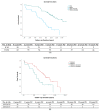Very Long-Term Follow-Up in Cardiac Resynchronization Therapy: Wider Paced QRS Equals Worse Prognosis
- PMID: 34834528
- PMCID: PMC8620956
- DOI: 10.3390/jpm11111176
Very Long-Term Follow-Up in Cardiac Resynchronization Therapy: Wider Paced QRS Equals Worse Prognosis
Abstract
Background: Different electrocardiogram (ECG) findings are known to be independent predictors of clinical response to cardiac resynchronization therapy (CRT). It remains unknown how these findings influence very long-term prognosis.
Methods and results: A total of 102 consecutive patients (75 males, mean age 65 ± 10 years) referred to our center for CRT implantation had previously been included in this prospective observational study. The same patient group was now re-evaluated for death from all causes over a prolonged median follow-up of 10.3 years (interquartile range 9.4-12.5 years). During follow-up, 55 patients died, and 82% of the clinical non-responders (n = 23) and 44% of the responders (n = 79) were deceased. We screened for univariate associations and found QRS width during biventricular (BIV) pacing (p = 0.02), left ventricular (LV) pacing (p < 0.01), Δ LV paced-right ventricular (RV) paced (p = 0.03), age (p = 0.03), New York Heart Association (NYHA) class (p < 0.01), CHA2DS2-Vasc score (p < 0.01), glomerular filtration rate (p < 0.01), coronary artery disease (p < 0.01), non-ischemic cardiomyopathy (NICM) (p = 0.01), arterial hypertension (p < 0.01), NT-proBNP (p < 0.01), and clinical response to CRT (p < 0.01) to be significantly associated with mortality. In the multivariate analysis, NICM, the lower NYHA class, and smaller QRS width during BIV pacing were independent predictors of better outcomes.
Conclusion: Our data show that QRS width duration during biventricular pacing, an ECG parameter easily obtainable during LV lead placement, is an independent predictor of mortality in a long-term follow-up. Our data add further evidence that NICM and lower NYHA class are independent predictors for better outcome after CRT implantation.
Keywords: ECG; cardiac resynchronization; heart failure; pacing; very long-term follow-up.
Conflict of interest statement
The authors declare that they have no competing interest.
Figures

 : in person physician contact;
: in person physician contact;  : telephone physician contact; ECHO: trans-thoracic echocardiogram;
: telephone physician contact; ECHO: trans-thoracic echocardiogram;  : electrocardiogram;
: electrocardiogram;  : Minnesota Living with Heart Failure Questionnaire;
: Minnesota Living with Heart Failure Questionnaire;  : Device interrogation;
: Device interrogation;  : Interrogation on current NYHA class, hospitalizations;
: Interrogation on current NYHA class, hospitalizations;  : Deceased;
: Deceased;  : End of data collection and start statistical analysis).
: End of data collection and start statistical analysis).

References
-
- Köbe J., Dechering D.G., Rath B., Reinke F., Mönnig G., Wasmer K., Eckardt L. Prospective evaluation of electrocardiographic parameters in cardiac resynchronization therapy: Detecting nonresponders by left ventricular pacing. Heart Rhythm. 2012;9:499–504. doi: 10.1016/j.hrthm.2011.11.009. - DOI - PubMed
-
- Appert L., Menet A., Altes A., Ennezat P.V., Bardet-Bouchery H., Binda C., Guyomar Y., Delelis F., Castel A.-L., Goffic C.L., et al. Clinical Significance of Electromechanical Dyssynchrony and QRS Narrowing in Patients With Heart Failure Receiving Cardiac Resynchronization Therapy. Can. J. Cardiol. 2019;35:27–34. doi: 10.1016/j.cjca.2018.10.019. - DOI - PubMed
LinkOut - more resources
Full Text Sources
Research Materials

